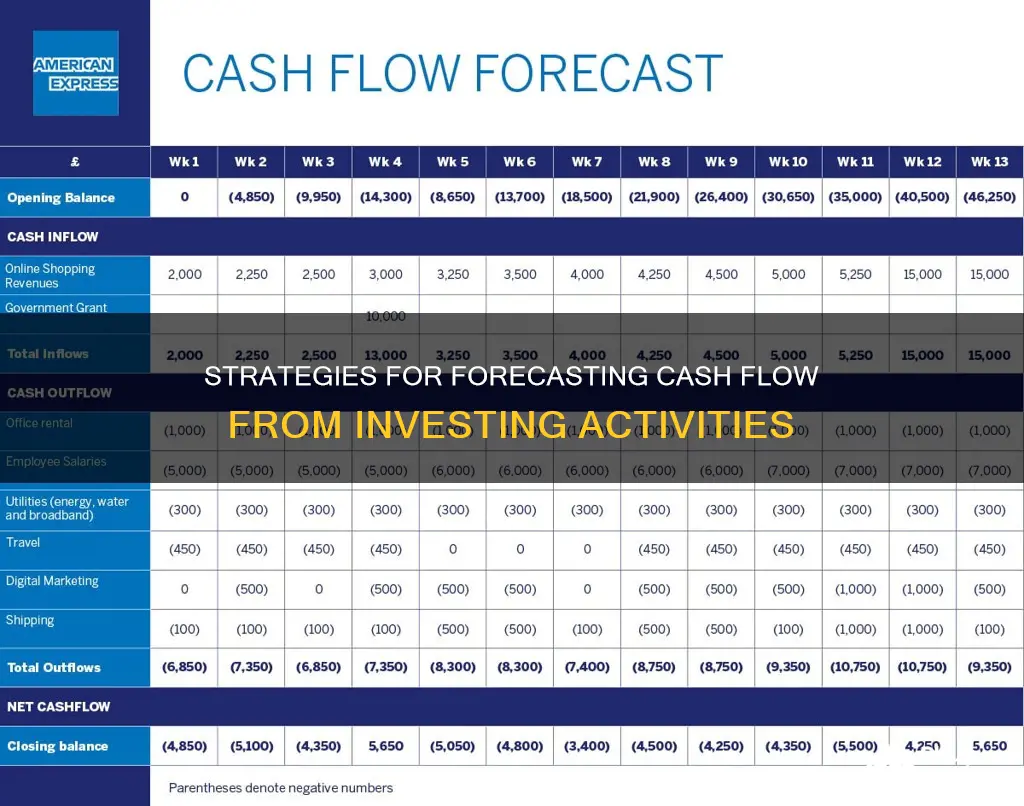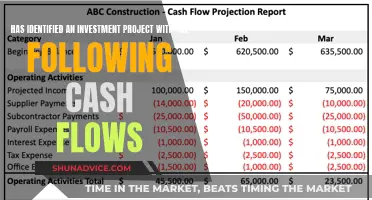
Forecasting cash flow is an essential part of financial management and business planning. It involves estimating the cash effect and timing of future sales and costs, and it's a critical tool for projecting a company's financial health. Cash flow can be broken down into three sections: operating activities, investing activities, and financing activities. This text will focus on forecasting cash flow from investing activities.
Investing activities include the purchase and sale of physical assets, investments in securities, and the acquisition of other companies. These activities provide an account of cash used in the purchase of non-current assets, also known as long-term assets, that will deliver value in the future.
To forecast cash flow from investing activities, one must consider the purchases or sales of property, equipment, other businesses, and marketable securities. This involves adding up all cash inflows and outflows related to investments. Inflows include proceeds from asset sales, dividends received, and interest earned on investments. Outflows include purchases of property, plant, equipment, and investments.
| Characteristics | Values |
|---|---|
| Definition | Cash flow from investing activities is a part of the cash flow statement that reports the cash inflows and outflows resulting from the investment activities. |
| Importance | It shows how a company is allocating cash for the long term. It provides insights into a company’s capital expenditure and investment strategies. |
| Types of Activities | Investing activities include purchases of physical assets, investments in securities, or the sale of securities or assets. |
| Calculation | To calculate cash flow from investing activities, add the purchases or sales of property and equipment, other businesses, and marketable securities. |
| Example | Hershey's net annual cash flow from investing activities for the year 2023 was -$1,198,676 thousand. |
| Positive Cash Flow | A positive cash flow indicates that a company is generating more cash from its investing activities than it is spending. |
| Negative Cash Flow | Negative cash flow from investing activities is not always a bad sign. It can indicate that a company is investing in assets, research, or other long-term development activities. |
| Forecasting | Cash flow forecasting involves estimating future sales and expenses to predict the timing and amount of cash inflows and outflows. |
| Tools | Cash flow forecasting software, Excel cash flow forecast template, or a combination of both. |
What You'll Learn
- Forecasting cash flow from investing activities in Excel
- How to forecast cash flow from investing activities for a new business?
- How to forecast cash flow from investing activities for a growing business?
- How to forecast cash flow from investing activities for a business seeking to optimise its capital structure?
- How to forecast cash flow from investing activities for a business with liquidity issues?

Forecasting cash flow from investing activities in Excel
Forecasting cash flow from investing activities is an important aspect of financial planning for businesses. It involves predicting the cash inflows and outflows related to the purchase or sale of assets, such as equipment or investments. This process helps businesses make informed decisions, plan for contingencies, and manage risks effectively. Here's a step-by-step guide to forecasting cash flow from investing activities using Microsoft Excel:
Step 1: Understand the Basics of Cash Flow from Investing Activities
Cash flow from investing activities includes the money that comes into and goes out of your business through the acquisition or disposal of long-term assets. This could include the purchase or sale of property, equipment, investments, or other fixed assets. It's important to note that this does not include the purchase of short-term assets, such as inventory, which would fall under operating activities.
Step 2: Identify the Sources of Cash Inflow and Outflow
Determine the sources of cash inflow and outflow related to investing activities. Inflows could include the sale of assets, proceeds from investments, or the sale of a subsidiary. Outflows would include the purchase of assets, investments, or any other long-term acquisitions. Make a comprehensive list of all potential sources to ensure you capture all relevant data.
Step 3: Gather Historical Data
Collect historical financial data, preferably for the past 12 months, to identify trends and anomalies. This data will help you understand the past performance of your business and make more accurate predictions for the future. Look for any inconsistencies or unusual spikes in the data, as these could indicate errors or one-time events that should not skew your forecast.
Step 4: Set Up Your Excel Worksheet
Open Microsoft Excel and create a new workbook. Set up separate worksheet tabs for different data categories, such as income, expenses, and projections. Label your columns with clear headings, such as Date, Description, Amount In, Amount Out, and Balance. Use rows to list specific items, such as rent, utilities, or various revenue streams. You can also use Excel's formatting tools to bold headers and use borders to separate sections, making your worksheet easier to read.
Step 5: Input Historical Data and Create Formulas
Start by listing all sources of income and expenses related to investing activities. Input the historical data you gathered in Step 3 into your Excel worksheet under the appropriate categories. You can use formulas to automate calculations and ensure accuracy. For example, use the SUM function to calculate the total cash inflows and outflows, and then calculate the net cash flow by subtracting total outflows from total inflows.
Step 6: Project Future Cash Flows
Based on the historical data and trends you identified, start projecting your future cash flows. Estimate your future income and expenses, considering any known changes, such as planned asset purchases or sales. Use your historical data as a guide and adjust for any anticipated fluctuations. It's important to strike a balance between optimism and realism in your projections.
Step 7: Analyze and Interpret Your Cash Flow Forecast
With your projections in place, it's time to analyze and interpret the results. Look at your overall cash flow to identify periods of surplus or deficit. Dig deeper into specific categories to spot any unexpected expenses or underperforming revenue streams. The cash flow statement, which breaks down your forecast into operating, investing, and financing activities, can provide a more detailed view and help you pinpoint specific areas for improvement.
Step 8: Adjust and Update Your Forecast Regularly
A cash flow forecast is a living document that should be regularly reviewed and updated. Schedule check-ins to compare your forecast with actual results, identifying any significant discrepancies. Analyze the reasons for any variances and adjust your forecast accordingly. This could involve updating income projections, revising cost estimates, or even tweaking your business strategy to ensure the accuracy and usefulness of your forecast.
Step 9: Utilize Advanced Excel Features
Excel offers a range of features to streamline the forecasting process. Formulas, such as SUMIF and SUMIFS, can automate calculations and ensure consistency. Conditional formatting can highlight specific data points, such as negative cash flow or expenses exceeding a certain threshold. Pivot tables allow you to summarize and analyze large datasets quickly, providing valuable insights into patterns and trends.
Step 10: Visualize Your Cash Flow Forecast
Visual aids can make your cash flow forecast more accessible and easier to communicate to stakeholders. Excel offers various chart types, such as line charts and bar charts, to display your data effectively. Line charts can show trends over time, while bar charts are useful for comparing categories. Alternatively, you can create a dashboard, a collection of charts and graphs, to provide a comprehensive overview of your financial situation.
Step 11: Consider Using Additional Tools
While Excel is a powerful tool, there are also other platforms and software that can assist with cash flow forecasting. For instance, Bricks is an innovative platform that integrates spreadsheets, documents, and presentations, with AI capabilities to automate various tasks and create visuals. Additionally, cloud-based forecasting tools like Xero, Fathom, and Futrli offer advanced functionalities that can save time and reduce manual errors.
Temporary Investments: Are They Really Cash?
You may want to see also

How to forecast cash flow from investing activities for a new business
Forecasting cash flow is an important aspect of financial management for a business. It involves estimating future sales and expenses to predict whether a business will have enough cash to run and expand. This is especially important for a new business, which may not have the data to make accurate predictions.
To forecast cash flow from investing activities, a business must first understand what these activities are. Investing activities include the purchase and sale of physical assets, investments in securities, and the acquisition of other companies. These are activities that generate or spend cash in the short term but are investments in the long-term health of the company.
For a new business, forecasting cash flow from investing activities can be done in several steps. Firstly, decide on a period to forecast, usually monthly. As a new business, you may not have past sales figures to refer to, so start by estimating all the cash outflows. This will give you an idea of how much money the business needs to bring in to cover its expenses. Cash outflows include the cost of making goods available, administration, and operation expenses.
Next, estimate your cash inflows, or sources of cash other than sales. These may include loans, selling off assets, tax refunds, grants, and investments from owners.
Then, compile these estimates into a cash flow forecast. Start with your opening bank balance and add in all the cash inflows, deducting the cash outflows for each period. The number at the end of each period is the closing cash balance, which will be the opening cash balance for the next period.
Finally, review your estimated cash flows against the actual cash flows for the period. This will help you identify any differences between your estimates and the reality, and you can adjust your forecasts accordingly.
It is important to note that cash flow from investing activities may be negative, especially for a new business, as it invests in assets and long-term development. This does not always indicate poor financial health, but it is something to monitor and manage to ensure the business can meet its obligations.
Securities Trading: Part of Investing Cash Flow?
You may want to see also

How to forecast cash flow from investing activities for a growing business
Forecasting cash flow from investing activities is an important part of understanding a company's financial health and planning for its future. This is especially true for a growing business, which will need to make strategic investments to support its expansion.
Understanding Cash Flow from Investing Activities
Cash flow from investing activities (CFI) is a section of a company's cash flow statement that details the cash inflows and outflows from investment activities. These activities include the acquisition and disposal of long-term assets, such as property, plant, and equipment, as well as investments in securities, bonds, debentures, and stocks. It also includes the acquisition or sale of other businesses.
To forecast cash flow from investing activities for a growing business, follow these steps:
- Choose a Time Period: Typically, cash flow forecasts are prepared for a three-year or five-year period. The first year is broken down into monthly periods, while subsequent years may be quarterly or yearly.
- Determine the Beginning Cash Balance: Start with the fiscal or calendar year-end amount of cash or cash equivalents, which can be found on the balance sheet.
- Forecast Revenues: Use sales team projections and expected growth rates to forecast sales and service revenues by type.
- Estimate Cash Inflows: In addition to sales, estimate other sources of cash inflows, such as loan repayments, asset sales, tax refunds, grants, or additional investments from owners.
- Calculate Cash Outflows: Work out the cost of making goods available and other business expenses, such as administration and operation costs. Also, consider 'one-off' expenses like bank fees and loan establishment fees.
- Compile the Information: Start with the opening bank balance (actual cash on hand) and add in all the cash inflows. Then, deduct the cash outflows for each period. The resulting number is the closing cash balance for that period, which becomes the opening cash balance for the next period.
- Review and Adjust: Compare your estimated cash flows to the actual cash flows for the period. This will help identify any discrepancies and adjust your forecast as needed.
Tips for Accuracy
- Consider seasonal changes and how they may affect cash flow.
- If you pay staff fortnightly, some months will have three payrolls.
- Don't forget to include annual registrations, subscriptions, and other periodic expenses.
- Put aside a portion of cash during months with higher inflows to help cover expenses during leaner months.
Cashing in on Treasury Investment Growth: Receipt Redemption Guide
You may want to see also

How to forecast cash flow from investing activities for a business seeking to optimise its capital structure
Forecasting cash flow is an important process for any business, and when it comes to investing activities, it becomes even more crucial. Here are some detailed instructions on how to forecast cash flow from investing activities for a business seeking to optimise its capital structure:
Understand Cash Flow from Investing Activities
Firstly, it is essential to grasp the concept of cash flow from investing activities. This section of a company's cash flow statement outlines the cash generated or spent on investment activities, such as the purchase or sale of physical assets, investments in securities, or long-term investments in the company's health and performance. These activities can either result in positive or negative cash flow. Positive cash flow is generated by sales or income, while negative cash flow is the money spent on investments. It's important to note that negative cash flow from investing activities is not always a negative indicator of financial health, as it may signal that the company is investing in its long-term growth.
Identify the Types of Investing Activities
There are various types of investing activities that can impact cash flow. These include:
- Purchase of fixed assets, such as property, plant, and equipment (PP&E)
- Purchase of investments, such as stocks or securities
- Sale of fixed assets or investment securities
- Collection of loans and insurance proceeds
- Capital expenditures (CapEx)
- Lending money
Determine the Period for Forecasting
When forecasting cash flow, it is essential to define the period you want to forecast. Commonly, businesses choose a monthly forecast period. However, you can also select quarterly, semi-annual, or annual periods, depending on your business needs and the industry's characteristics.
Forecast Income or Sales
To forecast cash flow effectively, you need to analyse past performance. Look at last year's figures to identify any trends or patterns in sales. Consider factors such as changes in your customer base, the economy (interest rates, unemployment rates), and the actions of your competitors. If you're a new business without historical data, start by estimating your cash outflows to understand how much income is required to cover expenses.
Estimate Cash Inflows and Outflows
In addition to sales or income, there are other sources of cash inflows, such as loan repayments, selling assets, rebates, grants, tax refunds, and investments from owners. On the other hand, cash outflows include payments to suppliers, business expenses, loan establishment fees, payments to owners, and investing surplus funds. Estimate these inflows and outflows based on your business's historical data and future expectations.
Compile the Estimates into a Cash Flow Forecast
Start with your opening bank balance and then add all the expected cash inflows while deducting the projected cash outflows for each period. The resulting number at the end of each period is the closing cash balance, which becomes the opening balance for the next period. This process will help you understand the net cash movement and identify any discrepancies between estimated and actual cash flows.
Optimise Capital Structure
When seeking to optimise its capital structure, a business must carefully blend debt and equity financing. Debt financing includes loans or bonds, while equity financing involves issuing shares. Each option has its advantages and considerations. Debt financing can be a lower-cost option due to tax-deductible interest payments, but high debt levels increase financial risk. On the other hand, equity financing provides a buffer against financial distress but dilutes ownership and may reduce per-share earnings. The optimal capital structure aims to maximise the company's market value while minimising its cost of capital.
Consider Hybrid Instruments
Hybrid instruments, such as convertible bonds or preferred stock, offer a mix of debt and equity features. They provide companies with flexible financing options and are often used strategically to balance risk and return effectively. These instruments can be particularly useful when a company wants to adapt to changing market conditions and seize new growth opportunities.
Assess Risk and Return
When optimising capital structure, it is crucial to consider the inherent risk-return trade-off. Higher debt levels can lead to increased returns for equity holders due to tax advantages and leverage, but they also bring a higher risk of financial distress and bankruptcy. Conversely, equity financing minimises bankruptcy risk but may result in a lower return on equity due to ownership dilution.
Build Investor Relations and Stakeholder Engagement
Strong relationships with investors, lenders, and stakeholders are vital when making capital structure decisions. Transparent communication, timely reporting, and responsiveness to investor concerns are key aspects of effective investor relations. Regular updates, comprehensive reports, and proactive addressing of stakeholder concerns demonstrate a commitment to their interests and the company's overall health.
Monitor and Adjust
Capital structure optimisation is an ongoing process. Continuously monitor the company's financial health, market conditions, and stakeholder feedback. Be prepared to make adjustments to your capital structure as needed to adapt to changing circumstances and ensure the company's long-term success.
Investing: Negative Cash Flow's Impact and Insights
You may want to see also

How to forecast cash flow from investing activities for a business with liquidity issues
Forecasting cash flow from investing activities is an important aspect of understanding a company's financial health and planning for its future. This is especially true for businesses with liquidity issues, which can benefit from accurate cash flow forecasts to make informed decisions and improve their financial flexibility. Here are the steps to forecast cash flow from investing activities for a business facing liquidity problems:
Step 1: Understand Investing Activities
Investing activities are one of the three main sections of a company's cash flow statement, along with operating and financing activities. Investing activities include the purchase or sale of physical assets, investments in securities, and the acquisition of fixed assets or property, plant, and equipment (PP&E). These activities are important for the company's long-term health and growth prospects.
Step 2: Identify the Data Sources
To forecast cash flow from investing activities, you will need to gather data from specific sources. This includes information on fixed assets, PP&E forecasts, and capital expenditures (CapEx). You will also need to review the company's balance sheet and income statement to identify changes in operating assets and liabilities, as well as depreciation and amortization.
Step 3: Calculate Cash Flow from Investing Activities
Analyze the data to calculate the net cash flow from investing activities. This involves adding up all the positive and negative investing activities listed on the cash flow statement. Positive cash flow comes from sales of investment securities or assets, while negative cash flow comes from spending on long-term assets, lending, or marketable securities.
Step 4: Interpret the Results
Keep in mind that negative cash flow from investing activities does not always indicate poor financial health. It could mean that the company is investing in long-term growth and development, such as research and development (R&D). Positive cash flow, on the other hand, indicates that the company's liquid assets are increasing, enabling it to cover obligations and reinvest in its business.
Step 5: Make Informed Decisions
For a business with liquidity issues, accurate cash flow forecasting allows for better decision-making. It helps identify areas where costs can be cut or optimized, and it enables the business to plan for times when cash flow may be low. This financial insight can also help improve relationships with suppliers and protect the business from future financial challenges.
In summary, forecasting cash flow from investing activities for a business with liquidity issues involves understanding investing activities, gathering relevant data, calculating cash flow, interpreting the results, and making informed decisions to improve the business's financial health and flexibility.
Gross PPE Cash Flow: Investing Strategies for Success
You may want to see also
Frequently asked questions
Cash flow from investing activities (CFI) is a section of a company's cash flow statement that reports the cash generated or spent from investment-related activities over a specific period. These activities include the purchase or sale of physical assets, investments in securities, or the acquisition of another company.
To calculate cash flow from investing activities, you need to add together the purchases and sales of property, equipment, other businesses, and marketable securities. This can be done by using the formula:
Cash flow from investing activities = CapEx/purchase of non-current assets + marketable securities + business acquisitions – divestitures (sale of investments).
A positive net cash flow from investing activities indicates that a company is generating more cash from its investing activities than it is spending. This suggests that the company is effectively managing its investments and may be acquiring assets or making strategic investments to enhance future growth and profitability.







